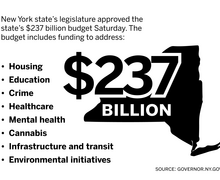Potter: Parties must work towards ending partisanship
This year, Republicans and Democrats are more polarized than any point within the past two decades, according to Pew Research Center. It is likely not coincidental that the 113th Congress has been called the least productive in recent history.
In the face of partisanship that has led to drastic events such as the 2013 shutdown, it is time to reevaluate and get politics back on track.
Colorado Republican Senate candidate Cory Gardner has been making waves because of his attempts to appeal to centrists in order to defeat incumbent Mark Udall (D-CO). According to a Sept. 3 Real Clear Politics article, Gardner recently released ads showing support for making birth control available without a prescription and for renewable energy.
In Gardner’s ads, he claims to be working across party lines and to be a “new kind of Republican.” This sentiment is exactly what we need to move away from partisanship and extreme polarization towards productivity and collaboration.
According to an Aug. 28 The New York Times article, Gardner is not alone in his centrism. Susan Collins (R-ME) and Lisa Murkowski (R-AK) vote along party lines 58 percent and 60 percent of the time, respectively. According to the article, both have a track record of independent voting and are not in jeopardy of losing their seats. They also are the only two Senators out of both parties who vote against their own party 20 percent of the time or more, which is the lowest number of senators in the past two decades.
These types of politicians are pivotal to begin a shift away from polarization. As of now, there are more individual Republicans crossing party lines than Democrats.
While individual Republican senators have showed their ability to compromise, the party as a whole is anti-centrist. The Tea Party movement has shifted the focus of the Republican Party from economic conservatism to social and religious conservatism. In my opinion, this change has fueled the development of the divide between the parties.
Democrats have also contributed to partisanship, but their current platform is generally less extreme than the Republican platform. It is essential that both parties work toward compromise.
Every state, and every district within, has different needs and values than what strictly falls within partisan expectations. Politicians need to be representing the constituents that elect them over their national parties.
Extremists have and will continue to play an important role in politics by bringing new ideology to the forefront and challenging the status quo. However, when the political system becomes saturated with extremists, the status quo becomes a lack of progress.
According to a June 12 Pew article, 38 percent of Americans “take a roughly equal number of liberal and conservative positions.” This is down from previous decades, but shows that the polarization in politics is not representative of the general population.
According to a July 2014 paper published by the Brookings Institute, expert Elaine Kamarck accredits intensifying polarization to the differences in ideology of primary election voters and general election voters. Kamarck suggests that this issue could be resolved by higher primary turnout rates.
Higher turnout rates would likely produce more centrist candidates and a more amicable relationship between the two parties. This seems to be a simple idea, but producing higher voting in a generally apathetic political climate is extremely difficult. Considering the low turnout rates in general and particularly in primary elections, politicians are less representative of the average voter within their party and more representative of ideologues. Average Americans can reduce partisanship by participating in the political process.
In order to facilitate political progress, partisanship level need to decline. Politicians like Gardner are exemplary of the type of bipartisanship needed for progress. Gardner’s platform crosses into Democratic territory and more Republicans should exhibit this type of compromise to help resolve polarization.
Rachel Potter is a senior political science and sociology major. Her column appears weekly. She can be reached at [email protected].
Published on September 9, 2014 at 12:38 am




